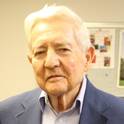
A new method of decomposing calcium sulfate has been demonstrated with a bench-scale fluidized bed reactor in which two reaction zones were established. A reducing zone was set up in the lower part of the reactor by partial combustion of natural gas and an oxiding zone in the upper part by the addition of secondary air. Through natural circulation in such a system. the solids were alternately reduced and oxidized. Both gypsum and anhydrite were decomposed in a continuous manner at temperatures ranging from 1910 to 2230°F. With temperatures of 2100°F and higher, the solids were 98 to 99% desulfurized, and with lower temperatures, the solids were desulfurized less. However, conversion to calcium sulfide was almost completely avoided over the whole temperature range. The process shows promise for treating waste and byproduct forms of calcium sulfate as well as natural minerals.
Available at: http://works.bepress.com/thomas-wheelock/29/

Reprinted (adapted) with permission from Ind. Eng. Chem. Process Des. Dev., 1975, 14 (3), pp 323–327. Copyright 1975 American Chemical Society.